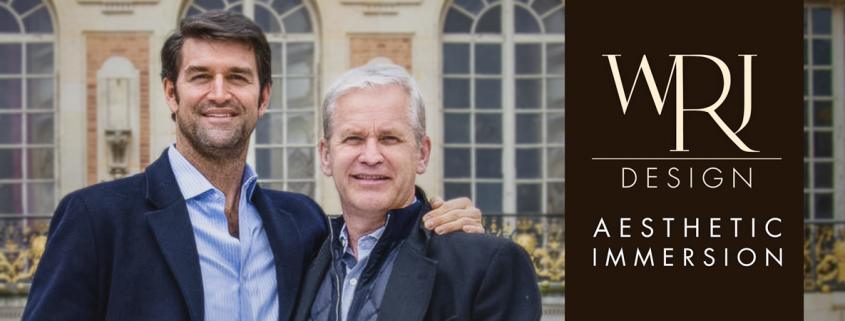WRJ Design: Aesthetic Immersion
After cultivating careers in London and New York, Rush Jenkins and Klaus Baer chose to root their lives and their firm, WRJ Design, in this rare landscape. Now profoundly inspired by place, they channel their experience with the sublime into every home they design.
From their roost in Wyoming, Rush and Klaus remain connected to international currents through exhibition design for Sotheby’s, private commissions and international sourcing trips. Boundlessly curious, they immerse themselves simultaneously in nature and the traditions of art, architecture, antiques and design. Whether hiking or traveling, the acclaimed designers translate their interactions with beauty into interiors as inspired as they are individual.
Befitting their global orientation, Rush took time from touring Italy to sketch his unique trajectory from Sotheby’s to the Tetons.
What is the history of WRJ’s relationship with Sotheby’s?
I studied fine art with Sotheby’s in London. While in London, I worked in Sotheby’s European furniture department and they introduced me to Sotheby’s in New York, where I worked in business development of European furniture for a year before becoming the Director of Design – a role that came about because my boss in New York was in charge of pitching new sales and placing artwork throughout the building. While doing a significant amount of the internal installation work, I recognized a need for someone to fill that role full-time. As Director of Design, I essentially designed all of the exhibits for Sotheby’s single-owner sales. After a year and a half, I opened my own firm and Sotheby’s became my client. All told, I’ve designed more than 40 exhibits for Sotheby’s. My relationship with Sotheby’s also led to work outside the auction house, most notably the exhibition I did for First Lady Nancy Reagan at the Reagan Library featuring Mrs. Reagan and her fashion aesthetic. Highlights of my tenure with Sotheby’s include: Kennedy Family Homes, Brooke Astor, Bill Blass, Mrs. Paul Mellon, Mrs. Jane Wrightsman, Laurance Rockefeller, Katharine Hepburn and Edvard Munch’s “The Scream,” which sold for a record-breaking price.
What inspires your exhibition designs? How do you get inspired?
For us, every collection is different and what we design reflects the unique character of that collection and the family or individual who cultivated it. We try and pull out the core elements of each collection. For instance, for Mrs. Mellon, the core of her collection was her gardens; her passion for horticulture could be seen in everything she collected from jewelry to paintings. In designing the exhibition for her collection, we identified two key sites on her beloved Virginia estate: an espalier connecting the house to a gardening pavilion and the potting shed itself with its astounding trompe l’oeil wall paintings. By recreating both places within the exhibition, we created an experience of beauty that unfolded piece by piece. The importance of design is to create something that is compelling and intriguing. An exhibition should unfold like a story, with a sense of discovery present at every turn.
How does experience with exhibition design inform your interior design projects?
Through my work with Sotheby’s, I have developed an innate understanding of art, antiques, objects, sculpture and porcelain. I know how objects relate in space and the placement of pieces in interiors. The essence of an exhibition is the architecture; you must get the architecture of the space right and only then can you suitably showcase pieces. The architecture of Brooke Astor’s home was very different than the Mellon estate. We try and create a sequence of rooms that reflects back to the original collection. We do the same in our interiors: We understand the architecture and how rooms flow into each other. We understand the proportion of the room and the proportion of objects and furniture in relation to the space. We understand balance, volume, space and harmony, and how it all comes together. And then we layer in other elements: color, texture, historical significance, artwork. The latter is crucial to our expertise: through Sotheby’s, we have probably placed or directed the placement of more than 40,000 works of art. We understand how everything works together to achieve harmony.
Whether approaching an exhibition or a residence, we embrace the challenge of articulating the aesthetic particular to that person, place or family. No two exhibitions are the same, just as no two clients are the same. Everyone has a different sense of harmony and balance and beauty. We know we have done a good job when we hear people saying, “This feels like the home of Bunny Mellon or Bill Blass.” That’s when we know we have succeeded with an exhibition. A home presents a different paradigm for success: We strive to express our client’s layered lives through their environments, and we know we have achieved that when they see their personal history and lifestyle reflected all around them. It’s one thing to recreate the spirit of someone’s collection in a fresh way, but quite another to capture the dynamism of a life as its being lived. We rise to the honor of both design challenges.



